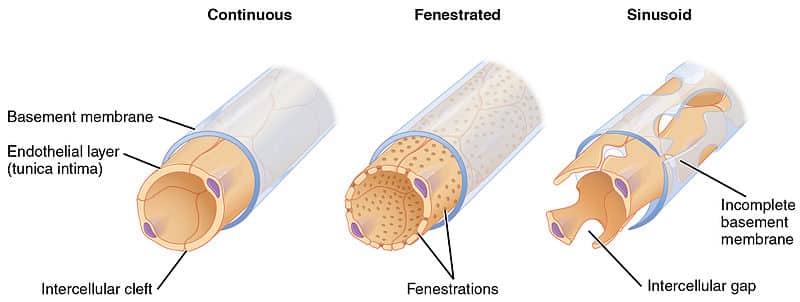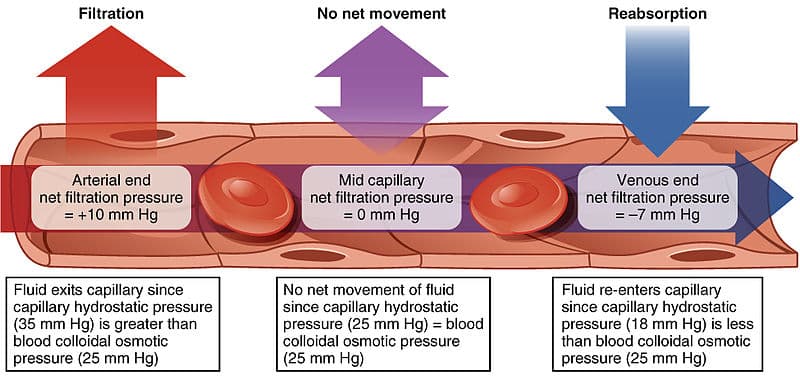Capillary exchange between blood and tissues is essential to deliver nutrients and remove waste products. In this article, we shall look at how molecules move between capillaries and tissues as well as related clinical conditions.
Fick’s Law
Fick’s law states that: “the rate of diffusion is proportional to the concentration difference and area available for diffusion”. It also states that: “the rate of diffusion is inversely proportional to the diffusion distance”.
The structure of capillaries facilitates efficient exchange, by optimising Fick’s law. To maximise the area available for diffusion, there are many capillaries supplying the same tissue. Moreover, constant blood flow through the capillaries maintains a large concentration gradient to allow rapid exchange of molecules with the tissue. Additionally, although a singular capillary has greater resistance, many capillaries in parallel reduce the resistance and allow efficient blood supply to the tissues. Finally, diffusion distance is minimised as the endothelium of the capillaries is just one cell thick and measures a few micrometres in diameter.
Small, lipid-soluble molecules, such as oxygen and carbon dioxide are able to freely diffuse across the membrane. However, molecules can also be exchanged via specialised channels or pores. The number of these channels or pores can vary depending on the function of the tissue. For example, the renal capillary bed is able to exchange water and electrolytes much more efficiently and selectively than in other capillaries. This is because the kidneys function to regulate ion concentrations and osmolarity while receiving approximately 25% of cardiac output.
Gas Exchange
A vital example of capillary exchange occurs between the terminal portions of the lungs and pulmonary capillaries. Therefore, pulmonary capillaries possess characteristics that allow for rapid and efficient diffusion. The capillaries optimise the diffusion rate by receiving a constant blood supply. They also have an average membrane thickness of only 0.6 micrometres and form a network of capillaries over the alveoli. Furthermore, the alveoli themselves have an extremely large surface area of seventy square metres to further increase the surface area available for diffusion.
However, common diseases can interfere with this optimisation. A useful way of thinking about these diseases is to frame them with respect to the variables of Fick’s law. For example, some pulmonary diseases cause fibrosis or oedema. This increases the diffusion distance that the molecule has to travel, thus decreasing the diffusion rate. Other diseases, such as emphysema, result in damage to the walls of the alveoli causing them to rupture. This consequently forms one larger air space and decreases the surface area available for gas exchange.
Finally, if the lungs are unable to ventilate correctly, such as in restrictive lung diseases, a shallower concentration gradient is established, and the diffusion rate is impaired.
Starling Forces
Fluid movement between the capillaries and tissues is controlled by four forces:
- Blood hydrostatic pressure: the pressure exerted by blood in the capillaries against the capillary wall. This pressure forces fluid out of the capillary.
- Blood colloid osmotic (oncotic) pressure: the pressure exerted by proteins in the blood, mostly by albumin in the capillaries. This pressure is attempting to pull fluid into the blood. Proteins in the plasma are normally too large to diffuse into the interstitium, however, in certain scenarios, such as in inflammation, these proteins can diffuse out.
- Interstitial hydrostatic pressure: the pressure of the fluid in the interstitium. This pressure forces fluid back into the capillary.
- Interstitial colloid osmotic (oncotic) pressure: the pressure of the proteins in the interstitium. This pressure pulls fluid out of the capillary.
Clinical Relevance – Kwashiorkor
Kwashiorkor is a disease caused by severe malnutrition, particularly when there is reduced protein intake. Due to the lack of protein, the liver produces fewer plasma proteins, such as albumin. Therefore, this will decrease the blood colloid osmotic pressure and thus reduce capillary exchange. This is because less fluid will be drawn back into the capillaries and remain in the tissue/interstitium.
This build-up of fluid in the interstitium is a symptom common to many diseases and is known as oedema. In Kwashiorkor, oedema may mask the typical muscle wastage commonly seen in other malnutrition diseases. Hence patients with Kwashiorkor have distended abdomens but thin extremities.
Inflammation
Inflammation occurs in response to cell injury and is another mechanism that can be explained in terms of Starling forces. Inflammation stimulates dilation of arterioles and therefore increases the hydrostatic pressure in the capillaries. Additionally, chemicals such as histamine cause the capillaries to become more permeable and allows proteins from the blood to flow into the interstitium. This increases the colloid osmotic force from the interstitium. These two factors both cause an increase of fluid to move out into the interstitium and explains the typical swelling seen in inflamed areas.


